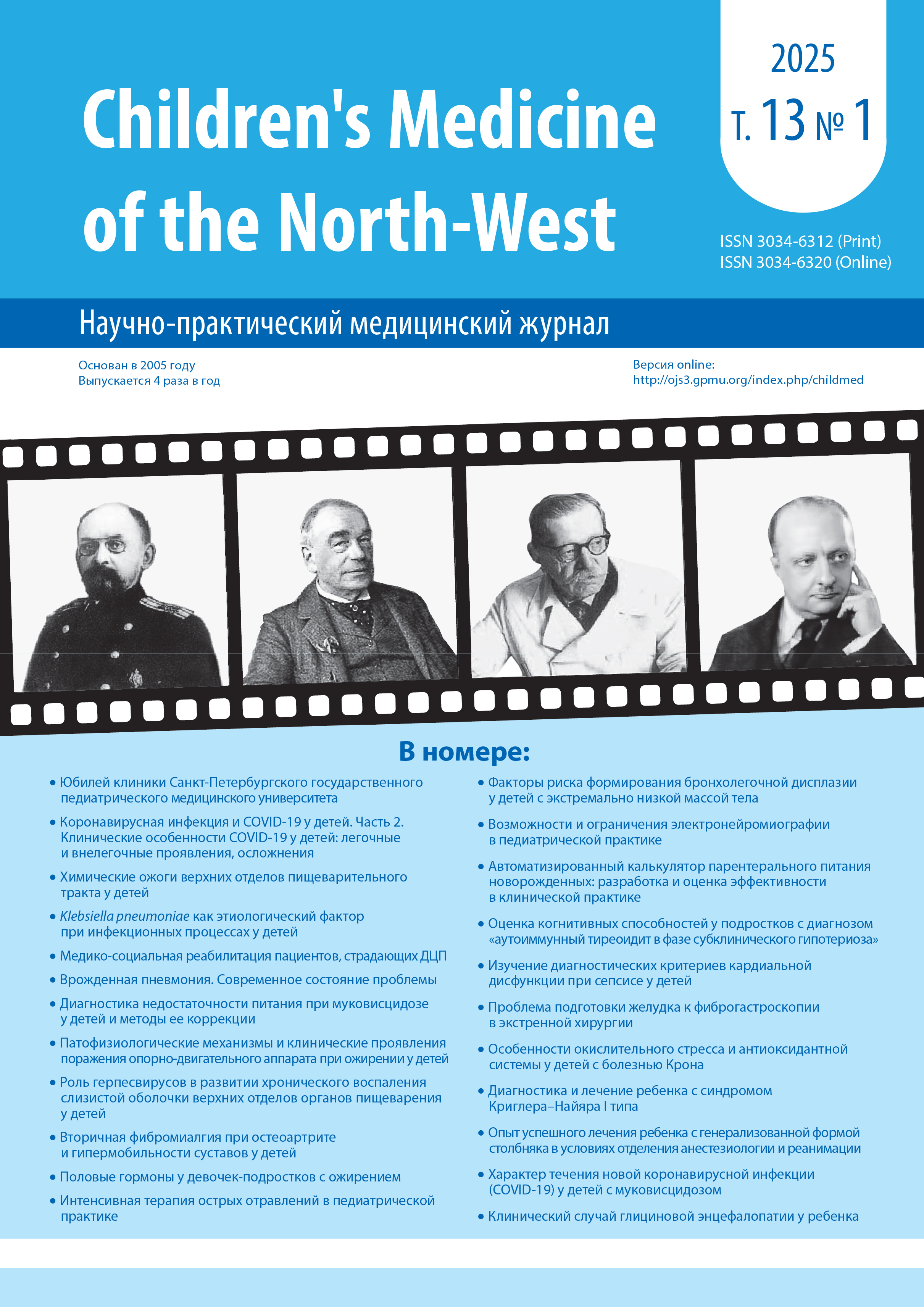RISK FACTORS FOR THE DEVELOPMENT OF BRONCHOPULMONARY DYSPLASIA IN CHILDREN WITH EXTREMELY LOW BODY WEIGHT
Abstract
Introduction. Contemporary methods of preterm infants' treatment have considerably reduced the mortality rate of newborns with extremely low body weight (ELBW), but the risk for thе infants to develop bronchopulmonary dysplasia is very high. Preterm infants with immature lungs often require artificial lung ventilation and additional oxygen therapy, which both may result in the development of bronchopulmonary dysplasia (BPD). The purpose of the study is to identify the most significant characteristics influencing the formation of clinically significant bronchopulmonary dysplasia (BPD), to assess their mutual influence and prognostic significance. Materials and methods. Research design: prospective, observational, single-center. The clinical and anamnestic characteristics of children born in the Perm Region Perinatal Center with extremely low body weight (ELBW) and with a gestation period less than 30 weeks from birth to 36 weeks of postconceptual age were studied. The analysis of the clinical and paraclinical characteristics of the entire cohort of children and the analysis of the maternal anamnesis were carried out. Results. The correlation and patterns were found in children with ELBW who developed moderate and severe BPD. It has been revealed that children with ELBW who have developed moderate to severe BPD have significantly lower birth weight, lower gestational age, lower Apgar score at 5 minutes of life, higher Silverman score, and need higher oxygen concentrations in the first week of life. Conclusion. It is possible to determine the key clinical and anamnestic features of the development of moderate and severe BPD in children with ELBW. The issue of finding ways to reduce the severity of BPD using already known prognostic criteria, as well as identifying new ones, remains important.
References
Bonadies L., Zaramella P., Porzionato A., Perilongo G., Muraca M., Baraldi E. Present and Future of Bronchopulmonary Dysplasia. J Clin Med. 2020;9(5):1539. DOI: 10.3390/jcm9051539.
Nuytten A. et al. Postnatal Corticosteroids Policy for Very Preterm Infants and Bronchopulmonary Dysplasia. Neonatology. 2020;117(3):308–315.
Siffel C., Kistler K.D. et al. “Global incidence of bronchopulmonary dysplasia among extremely preterm infants: a systematic literature review”. J Matern Fetal Neonatal Med. 2021;34:1721–31. DOI: 10.1080/14767058.2019.1646240.
Бронхопульманарная дисплазия: клинические рекомендации. 2024. Доступно по: https://cr.minzdrav.gov.ru/recomend/377_2 (дата обращения: 12.09.2024).
Овсянников Д.Ю., Малахов А.Б., Дегтярева Д.Н. Бронхолегочная дисплазия. М.; 2020.
Voynow J.A. “New” bronchopulmonary dysplasia and chronic lung disease. Pediatr Respir Rev. 2017;24:17–18.
Смертность и рождаемость в Перми. 2024. Доступно по: https://gogov.ru/natural-increase/perm (дата обращения: 22.08.2024).
Федеральная служба государственной статистики. 2024. Доступно по: https://rosstat.gov.ru/ (дата обращения: 22.08.2024).
Парентеральное питание новорожденных: клинические рекомендации. 2015. Доступно по: https://neonatology.pro/wp-content/uploads/2015/10 /klinrec_parenteral_2015.pdf (дата обращения: 10.09.2019).
Jeon G.W., Oh M., Chang Y.S. Definitions of bronchopulmonary dysplasia and long-term outcomes of extremely preterm infants in Korean Neonatal Network. Sci Rep. 2021;11(1):24349. DOI: 10.1038/s41598-021-03644-7.



